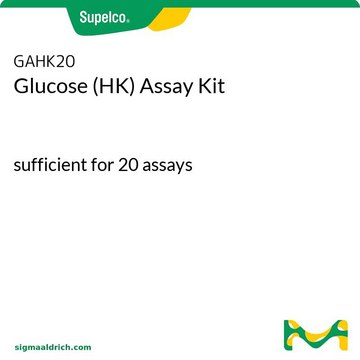MAK465
Glycogen Assay Kit
sufficient for 100 colorimetric or fluorometric tests
Synonym(s):
Glycogen Quantification Kit
Sign Into View Organizational & Contract Pricing
All Photos(1)
About This Item
UNSPSC Code:
12161503
NACRES:
NA.84
Recommended Products
Quality Level
application(s)
pharmaceutical
detection method
colorimetric
fluorometric
relevant disease(s)
diabetes; endocrinological disorders
shipped in
wet ice
storage temp.
−20°C
General description
Glycogen is a branched polysaccharide of glucose units linked by α-1,4 glycosidic bonds and α-1,6 glycosidic bonds. It is stored primarily in the liver and muscle and forms an energy reserve that can be quickly mobilized to meet a sudden need for glucose. The most common glycogen metabolism disorder is found in diabetes, in which liver glycogen can be abnormally accumulated or depleted due to abnormal amounts of insulin. Genetic glycogen storage diseases have been associated with various inborn errors of metabolism caused by deficiencies of enzymes necessary for glycogen synthesis or breakdown.
Features and Benefits
- Linear detection range: 2 to 200 µg/mL glycogen for colorimetric assays and 0.2 to 20 µg/mL for fluorometric assays.
- Convenient room temperature assay. The procedure involves adding a single working reagent, and and takes only 30 minutes
Suitability
The kit is suitable for the quantitative determination of glycogen in biological samples such as tissue and cells, as well as the evaluation of drug effects on glycogen metabolism.
Principle
The Glycogen Assay Kit uses a single working reagent that combines the enzymatic break down of glycogen and the detection of glucose in one step. The color intensity of the reaction product at 570 nm or fluorescence intensity at λEx = 530 nm/λEm = 585 nm is directly proportional to the glycogen concentration in the sample.
Signal Word
Danger
Hazard Statements
Precautionary Statements
Hazard Classifications
Resp. Sens. 1
Storage Class Code
10 - Combustible liquids
WGK
WGK 3
Choose from one of the most recent versions:
Certificates of Analysis (COA)
Lot/Batch Number
Sorry, we don't have COAs for this product available online at this time.
If you need assistance, please contact Customer Support.
Already Own This Product?
Find documentation for the products that you have recently purchased in the Document Library.
Our team of scientists has experience in all areas of research including Life Science, Material Science, Chemical Synthesis, Chromatography, Analytical and many others.
Contact Technical Service


